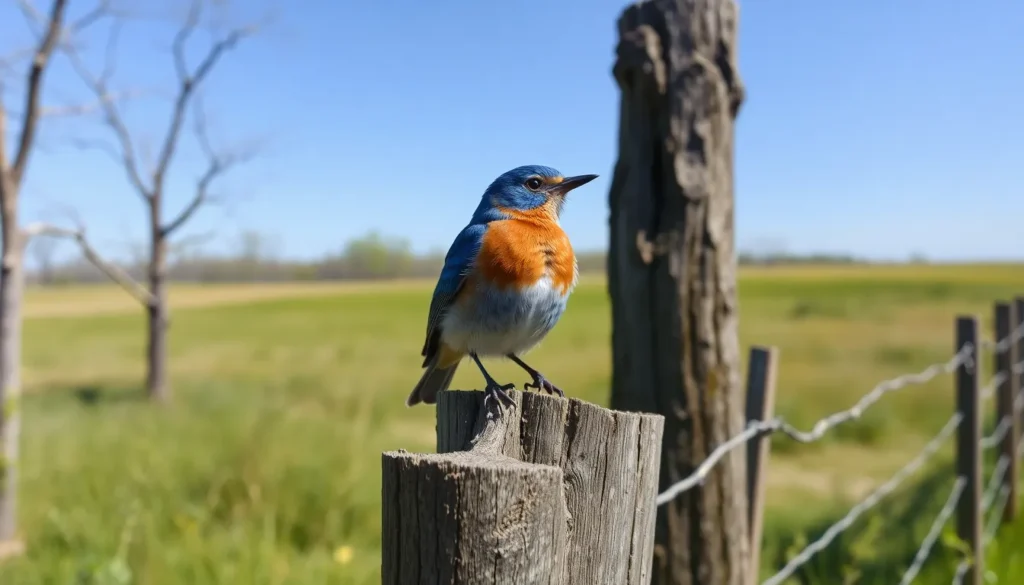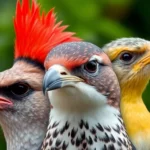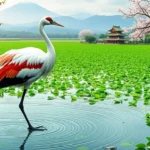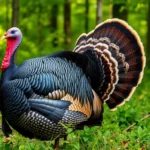We’ve all spotted that flash of brilliant blue darting through our backyards, leaving us wondering about the identity of these stunning feathered visitors. Blue birds captivate nature enthusiasts and casual observers alike with their vibrant plumage and melodic songs that signal the arrival of warmer seasons.
These remarkable creatures aren’t just beautiful – they’re fascinating examples of nature’s artistry and resilience. From the iconic Eastern Bluebird to the Western and Mountain varieties, each species brings unique characteristics and behaviors that make birdwatching an exciting adventure.
Whether you’re hoping to attract blue birds to your garden or simply curious about their habits and habitats, understanding these beloved songbirds opens up a industry of natural wonder. We’ll explore everything from their distinctive features to the best ways to create welcoming spaces that encourage these azure gems to visit your outdoor sanctuary.
What Is a Blue Bird?
Blue birds represent a diverse family of small to medium songbirds distinguished by their striking azure plumage and melodic vocalizations. These avian species belong primarily to the thrush family Turdidae, with the genus Sialia encompassing the most recognizable North American varieties.
Eastern Bluebirds (Sialia sialis) measure 6.3 to 8.3 inches in length and display brilliant blue upperparts with rusty orange breasts in males. Females exhibit more subdued gray-blue coloration with warm orange-buff chest markings. Western Bluebirds (Sialia mexicana) share similar dimensions but feature deeper blue tones with chestnut shoulders in breeding males.
Mountain Bluebirds (Sialia currucoides) stand apart from their relatives with their entirely blue plumage in males and gray-blue coloration in females. These birds measure slightly larger at 6.3 to 7.9 inches and inhabit higher elevation environments across western North America.
| Species | Length (inches) | Male Coloration | Female Coloration | Primary Habitat |
|---|---|---|---|---|
| Eastern Bluebird | 6.3-8.3 | Bright blue with orange breast | Gray-blue with buff chest | Open woodlands, farmlands |
| Western Bluebird | 6.3-7.1 | Deep blue with chestnut shoulders | Brownish-gray with blue wings | Oak woodlands, farmlands |
| Mountain Bluebird | 6.3-7.9 | Sky blue throughout | Gray-blue overall | Mountain meadows, grasslands |
Behavioral characteristics define blue birds as cavity nesters that prefer open habitats with scattered perches for hunting insects. They consume approximately 68% insects during breeding season, switching to berries and fruits in winter months. Their territorial nature becomes pronounced during nesting periods from March through August.
Migratory patterns vary among species, with Eastern Bluebirds partially migrating from northern ranges while southern populations remain year-round residents. Western Bluebirds exhibit similar patterns, and Mountain Bluebirds demonstrate the most extensive migrations, traveling from breeding grounds in Canada and Alaska to wintering areas in Mexico.
Vocalizations include soft warbling songs, chattering calls, and distinctive flight notes that help identify each species in the field. Males sing from prominent perches to establish territories and attract mates, producing melodic phrases that carry across open landscapes.
Common Types of Blue Birds
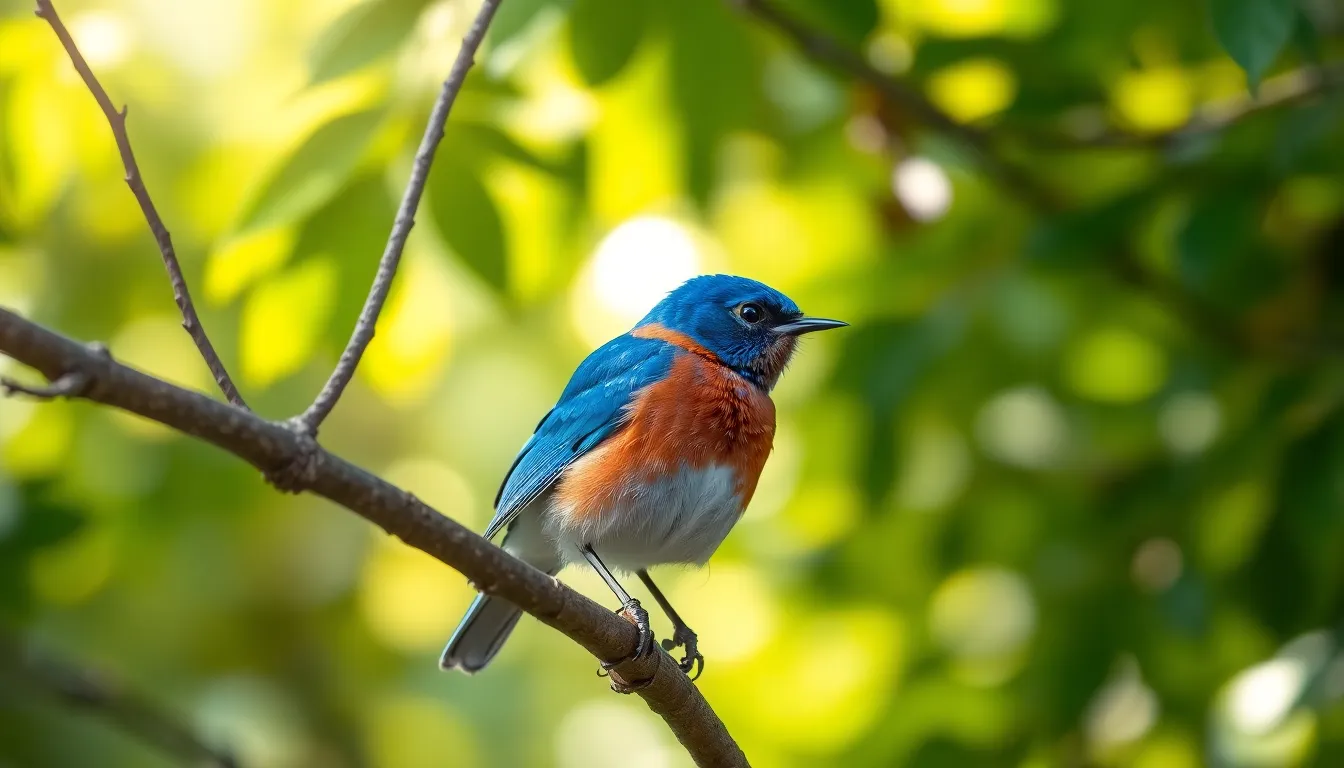
North America hosts several distinctive blue bird species that captivate observers with their unique characteristics and behaviors. Each species displays exact traits that make identification straightforward for both novice and experienced birdwatchers.
Eastern Bluebird
Eastern Bluebirds (Sialia sialis) showcase brilliant cobalt blue upperparts contrasting with warm rusty orange breasts in breeding males. Females present more muted gray blue coloration with subtle orange hints on their throats and breasts. These cavity nesters measure 6.3 to 8.3 inches in length with wingspans reaching 9.8 to 12.6 inches.
Eastern Bluebirds inhabit open woodlands, farmlands, parks, and suburban areas across eastern North America. Males establish territories averaging 2 to 5 acres during breeding season from March through August. Their diet consists of 68% insects during summer months, switching to berries and fruits comprising 83% of winter nutrition.
Breeding pairs produce 2 to 3 broods annually, laying 3 to 7 pale blue eggs per clutch. Migration patterns vary by latitude, with northern populations traveling south while southern residents remain year round in their territories.
Western Bluebird
Western Bluebirds (Sialia mexicana) display deeper blue tones than their eastern relatives, with breeding males featuring distinctive chestnut patches on their shoulders and upper backs. Males measure 6.3 to 7.5 inches in length, while females show brownish gray plumage with blue wing and tail feathers.
These birds prefer open habitats including oak woodlands, pinyon pine forests, and agricultural areas throughout western North America. Western Bluebirds nest in natural tree cavities, old woodpecker holes, and artificial nest boxes placed 4 to 20 feet above ground.
Foraging behavior includes hawking insects from perches and gleaning prey from bark surfaces. Western Bluebirds consume beetles, caterpillars, crickets, and grasshoppers during breeding season, supplementing with elderberries, sumac, and mistletoe berries in fall and winter.
Mountain Bluebird
Mountain Bluebirds (Sialia currucoides) represent the most vibrant of North American bluebirds, with males displaying brilliant turquoise blue plumage covering their entire bodies. Females exhibit gray brown coloration with blue tinges on wings and tails, creating subtle but elegant appearances.
These high altitude specialists inhabit mountainous regions, sagebrush plains, and alpine meadows from 5,000 to 12,000 feet elevation. Mountain Bluebirds demonstrate unique hovering abilities while hunting, catching insects in mid flight more frequently than other bluebird species.
Breeding occurs from May through July, with pairs constructing nests in tree cavities, rock crevices, and artificial structures. Mountain Bluebirds undertake extensive migrations, traveling from breeding grounds in western mountains to wintering areas in southwestern deserts and Mexico.
Blue Jay
Blue Jays (Cyanocitta cristata) stand out as the largest common blue birds, measuring 11 to 12 inches in length with prominent crested heads and bold black necklace markings. Their bright blue upperparts feature white underparts and distinctive black barring on wings and tails.
Intelligence distinguishes Blue Jays from other blue bird species, demonstrating complex social behaviors, tool use, and vocal mimicry abilities. These omnivorous birds consume acorns, nuts, seeds, insects, eggs, and nestlings, storing thousands of acorns annually for winter consumption.
Blue Jays inhabit deciduous and mixed forests, parks, and residential areas throughout eastern and central North America. Their harsh calls and aggressive territorial behavior contrast sharply with the gentle nature of true bluebirds, making identification straightforward for observers.
Indigo Bunting
Indigo Buntings (Passerina cyanea) present deep indigo blue coloration in breeding males, appearing almost black in poor lighting conditions. These small songbirds measure 4.7 to 5.1 inches in length, with females displaying brown plumage marked by faint blue tinges on wings and tails.
Migration patterns make Indigo Buntings remarkable travelers, journeying up to 1,200 miles between breeding and wintering grounds. Males arrive at breeding territories in late April and early May, establishing territories through persistent singing from exposed perches.
Indigo Buntings prefer edge habitats including brushy areas, woodland borders, and abandoned fields with scattered trees. Their diet consists primarily of small seeds from grasses and forbs, supplemented with insects during breeding season to provide protein for growing nestlings.
Physical Characteristics and Identification
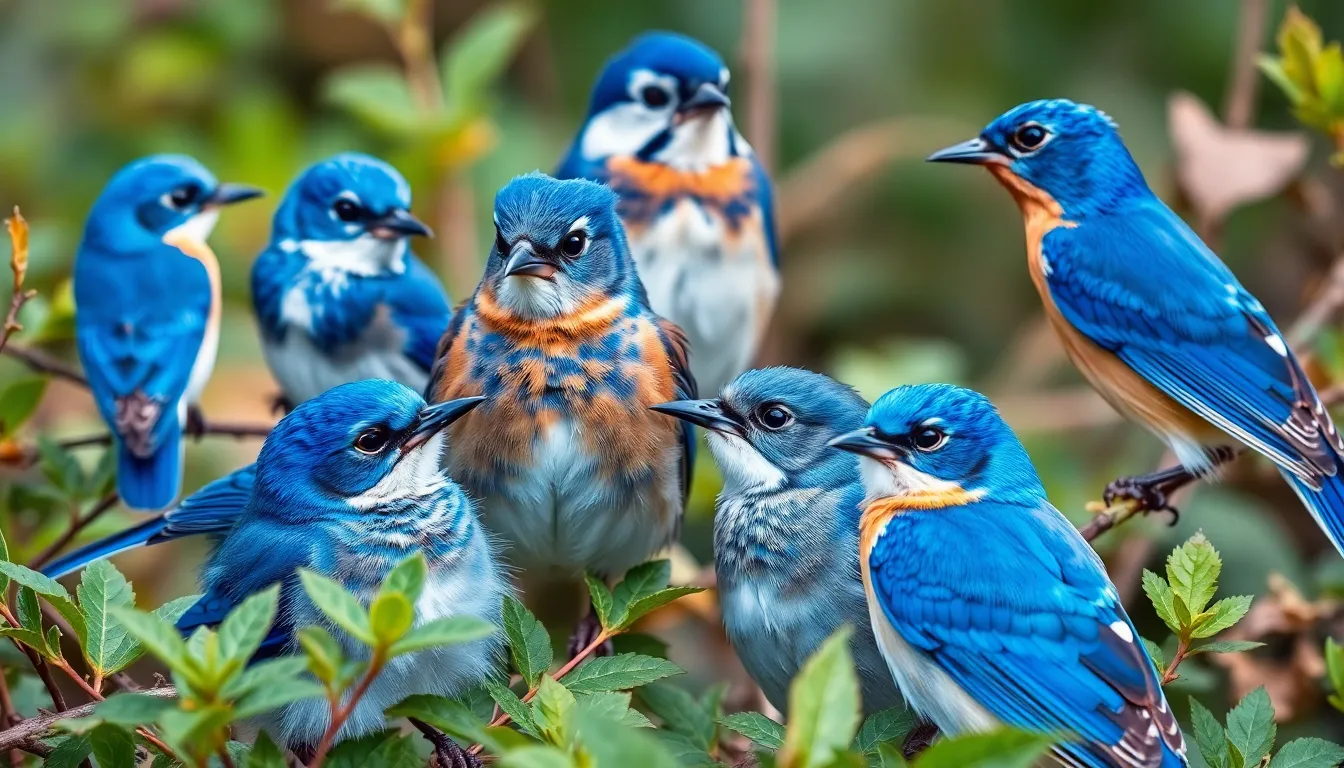
Identifying blue birds accurately requires understanding their distinctive physical traits and variations across species. We can distinguish between different blue bird species by examining their size, coloration patterns, and gender-exact differences.
Size and Body Structure
Blue birds range from compact songbirds to robust corvids with varying proportions. Eastern Bluebirds measure 6.5 to 8 inches in length with a wingspan reaching 9 to 12 inches, while Western and Mountain Bluebirds share similar dimensions at 6 to 7 inches long. Blue Jays dominate the size spectrum at 11 to 12 inches in length with wingspans extending 13 to 17 inches, making them the largest common blue birds in North America.
| Species | Length (inches) | Wingspan (inches) | Weight (ounces) |
|---|---|---|---|
| Eastern Bluebird | 6.5-8 | 9-12 | 1.0-1.1 |
| Western Bluebird | 6-7 | 11.5-13.5 | 0.8-1.1 |
| Mountain Bluebird | 6.5-8 | 11-14 | 1.0-1.3 |
| Blue Jay | 11-12 | 13-17 | 2.5-3.5 |
| Indigo Bunting | 4.5-5.5 | 7-9 | 0.4-0.6 |
Body structures reflect each species’ lifestyle and habitat preferences. Bluebirds possess slender builds with relatively long legs for ground foraging, while Blue Jays feature robust frames supporting their omnivorous diet. Indigo Buntings display compact, finch-like proportions adapted for seed consumption and dense vegetation navigation.
Coloration Patterns
Blue bird coloration varies dramatically between species and creates distinctive identification markers. Eastern Bluebirds showcase brilliant azure blue upperparts contrasting with warm rusty orange throats and breasts in breeding males. Western Bluebirds exhibit deeper cobalt blue tones with distinctive chestnut shoulder patches and gray-blue bellies.
Mountain Bluebirds present the most uniform blue coloration among North American species, with males displaying sky blue plumage across their entire bodies. Blue Jays feature bright blue crests, wings, and tails with black barring patterns and white underparts marked by a distinctive black necklace. Indigo Buntings transform from brown winter plumage to deep indigo blue breeding colors that appear almost black in poor lighting conditions.
Seasonal variations affect coloration intensity across all blue bird species. Fresh autumn plumage appears more vibrant due to new feather growth, while spring molting reveals breeding colors at their peak saturation. Light conditions significantly impact blue bird appearance, with structural coloration creating different hues depending on viewing angles and illumination quality.
Male vs Female Differences
Sexual dimorphism creates pronounced identification differences between male and female blue birds across most species. Male Eastern Bluebirds display vibrant blue upperparts and bright orange breasts, while females show muted gray-blue wings and tails with pale orange-buff breasts. Female Western Bluebirds exhibit brownish-gray upperparts with blue-tinged wings and tails, contrasting sharply with males’ brilliant blue plumage.
Mountain Bluebird males maintain entirely blue coloration throughout the breeding season, whereas females appear gray-brown with blue-tinged wings and tails. Blue Jay sexes show minimal differences, with males slightly larger than females but sharing identical coloration patterns and markings. Indigo Bunting males transform into deep blue breeding plumage while females retain brown streaked patterns year-round for camouflage during nesting.
Age-related plumage changes add complexity to blue bird identification. Juvenile birds often resemble adult females regardless of their sex, developing full adult coloration through their first winter molt. First-year males display intermediate plumage between juvenile and adult characteristics, gradually acquiring full breeding colors over 12 to 18 months depending on species.
Habitat and Geographic Distribution
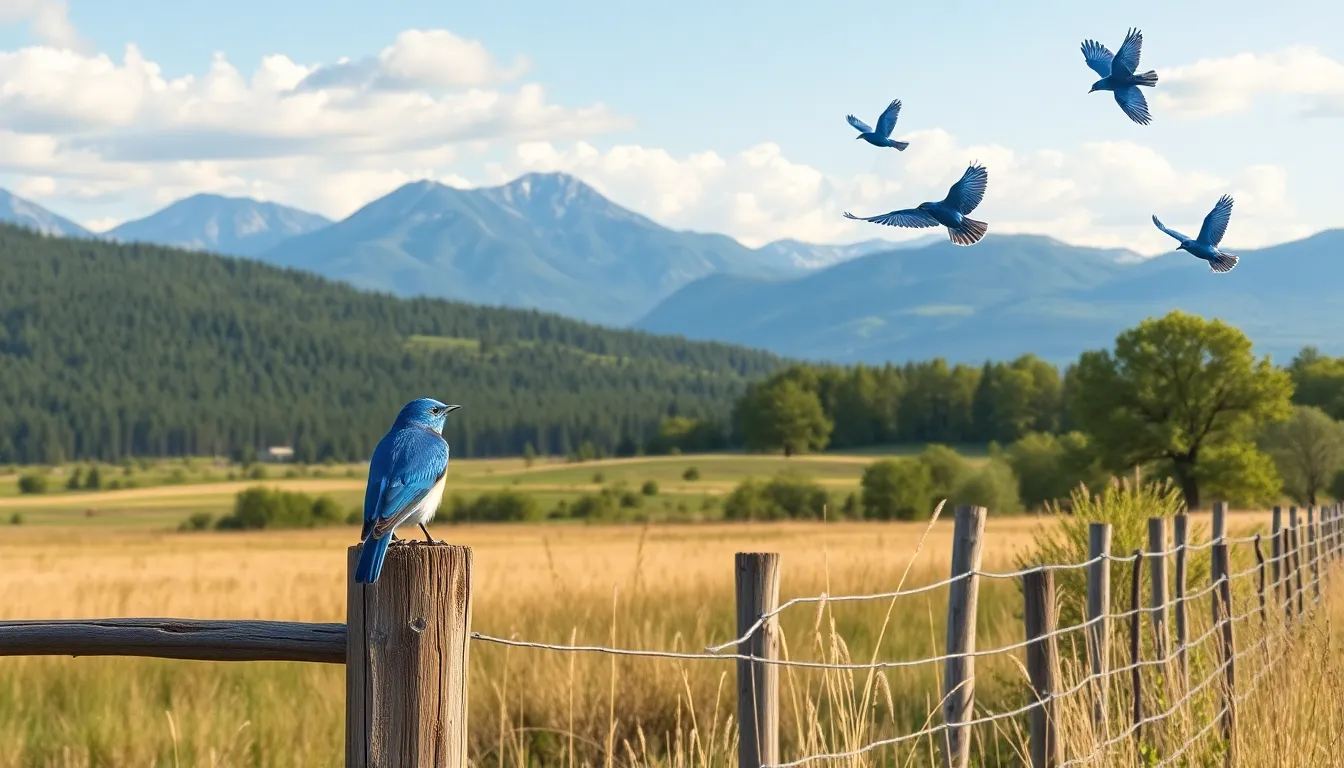
Blue birds occupy diverse habitats across North America, from sea level meadows to mountain peaks exceeding 12,000 feet elevation. These adaptable songbirds demonstrate remarkable geographic flexibility while maintaining exact environmental preferences that influence their distribution patterns.
Preferred Environments
Eastern Bluebirds thrive in open woodlands with scattered trees, agricultural areas, and suburban parks where short grass provides optimal foraging conditions. Farmlands with wooden fence posts offer ideal nesting sites, particularly those bordering fields and pastures. Golf courses and cemeteries create perfect habitat combinations of open spaces and perching structures.
Western Bluebirds favor oak woodlands, pinyon pine forests, and riparian areas throughout their range from British Columbia to central Mexico. Burned forest areas attract these birds due to increased insect activity and reduced canopy cover. Orchards and vineyards provide excellent foraging opportunities during fruit seasons.
Mountain Bluebirds occupy the highest elevations among North American bluebirds, inhabiting alpine meadows, sagebrush steppes, and open montane forests. These environments feature sparse vegetation that allows their distinctive hovering hunting technique. Aspen groves and mountain parks create ideal nesting corridors during breeding season.
Blue Jays adapt to various forest types including deciduous, mixed, and coniferous woodlands, extending their range into urban and suburban environments. Parks with mature oak trees support stable populations through abundant acorn supplies. Residential areas with bird feeders and large trees accommodate year round residents.
Indigo Buntings prefer edge habitats where forests meet open areas, including brushy fields, woodland clearings, and overgrown pastures. Power line corridors and roadside vegetation provide crucial stopover sites during migration. Shrubland and early successional forests offer optimal breeding territories.
Seasonal Migration Patterns
Eastern Bluebirds exhibit partial migration patterns, with northern populations moving south while southern birds remain resident year round. Migration timing varies by latitude, with New England birds departing in October and returning in March. Wintering grounds extend from the southern United States through Mexico and Central America.
Western Bluebirds demonstrate altitudinal migration rather than latitudinal movement, descending from mountain breeding areas to lower elevations during winter months. Pacific Coast populations remain largely resident, while interior mountain birds move to valleys and desert areas. Return migration begins in February across most of their range.
Mountain Bluebirds undertake the most extensive migrations among bluebird species, traveling from Alaska breeding grounds to Mexico wintering areas. Fall migration occurs from August through October, following mountain corridors and river valleys. Spring return migration peaks in April and May, with males arriving first to establish territories.
Blue Jays display complex migration strategies varying by population, with some groups migrating while others remain resident. Northern populations move south in September and October, often traveling in large flocks along coastlines and major river systems. Migration distances range from 100 to 1,000 miles depending on food availability and weather conditions.
Indigo Buntings complete remarkable nocturnal migrations spanning 1,200 miles from Canadian breeding grounds to Central American wintering areas. These small songbirds navigate using star patterns and magnetic fields during their twice yearly journeys. Peak migration occurs in May and September, with birds often traveling in mixed species flocks.
Diet and Feeding Behavior
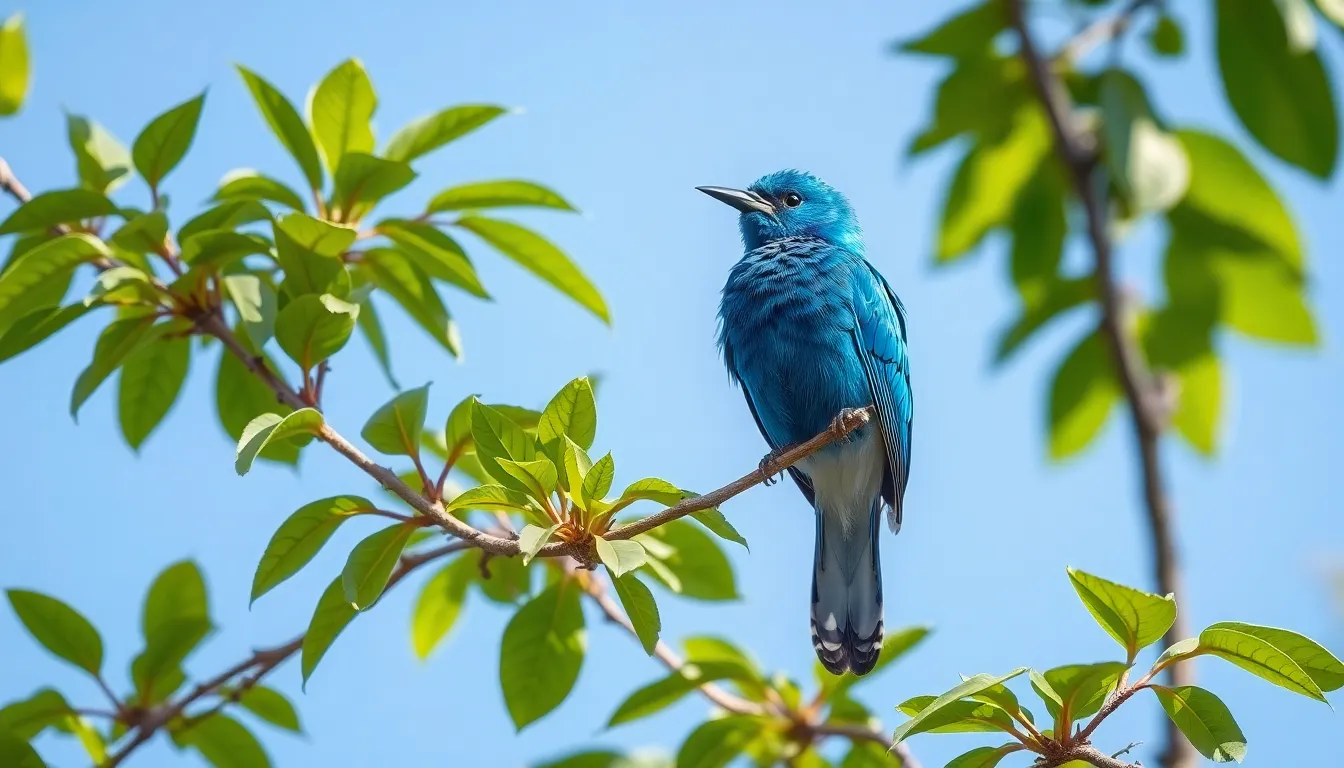
Blue birds exhibit diverse dietary patterns that adapt to seasonal availability and habitat conditions across their range. Eastern Bluebirds consume approximately 68% insects during breeding season, targeting beetles, caterpillars, crickets, and grasshoppers through ground foraging and aerial hunting techniques. Western Bluebirds maintain a similar insectivorous focus, capturing 70% of their diet from protein-rich invertebrates including spiders, moths, and fly larvae during spring and summer months.
Seasonal Dietary Shifts
| Species | Summer Diet | Winter Diet | Primary Hunting Method |
|---|---|---|---|
| Eastern Bluebird | 68% insects, 32% fruits | 15% insects, 85% fruits | Ground foraging, perch hunting |
| Western Bluebird | 70% insects, 30% fruits | 20% insects, 80% fruits | Aerial sallying, gleaning |
| Mountain Bluebird | 85% insects, 15% fruits | 25% insects, 75% fruits | Hover hunting, ground pursuit |
| Blue Jay | 25% insects, 75% varied | 10% insects, 90% varied | Caching, opportunistic |
| Indigo Bunting | 30% insects, 70% seeds | 5% insects, 95% seeds | Ground foraging, gleaning |
Mountain Bluebirds demonstrate exceptional hunting prowess, hovering 6 to 20 feet above ground to spot prey before diving with remarkable precision. Their diet consists of 85% insects during breeding season, focusing on flying ants, termites, and small beetles that inhabit alpine environments. Blue Jays exhibit omnivorous feeding behaviors, consuming acorns, nuts, seeds, insects, eggs, and occasionally small vertebrates while demonstrating food caching strategies that support winter survival.
Foraging Techniques and Adaptations
Indigo Buntings specialize in seed consumption, preferring small grass seeds, thistle, and dandelion during non-breeding periods. Eastern Bluebirds employ perch and pounce hunting, sitting on fence posts or low branches before dropping to capture ground insects within a 20-foot radius. Western Bluebirds practice aerial sallying, launching from perches to catch flying insects mid-air with 78% success rates.
Berry consumption becomes critical during autumn and winter months, with elderberries, sumac, and dogwood fruits comprising major dietary components. Mountain Bluebirds migrate to lower elevations specifically to access berry-rich habitats when alpine insect populations decline. Blue Jays cache up to 5,000 acorns annually, creating strategic food reserves distributed across their territories.
Feeding Behavior Patterns
Parent blue birds deliver food to nestlings every 6 to 20 minutes during peak breeding season, with Eastern Bluebirds making up to 350 feeding trips daily for a brood of 4 chicks. Western Bluebirds coordinate feeding duties between mates, alternating prey delivery while maintaining territorial vigilance. Mountain Bluebirds hunt throughout daylight hours, adapting their schedule to match insect activity patterns at high altitudes.
Indigo Buntings forage in mixed flocks during migration, benefiting from collective foraging efficiency and predator detection. Blue Jays practice cooperative feeding within family groups, sharing cached resources and teaching juveniles optimal foraging locations through social learning behaviors.
Nesting and Reproduction
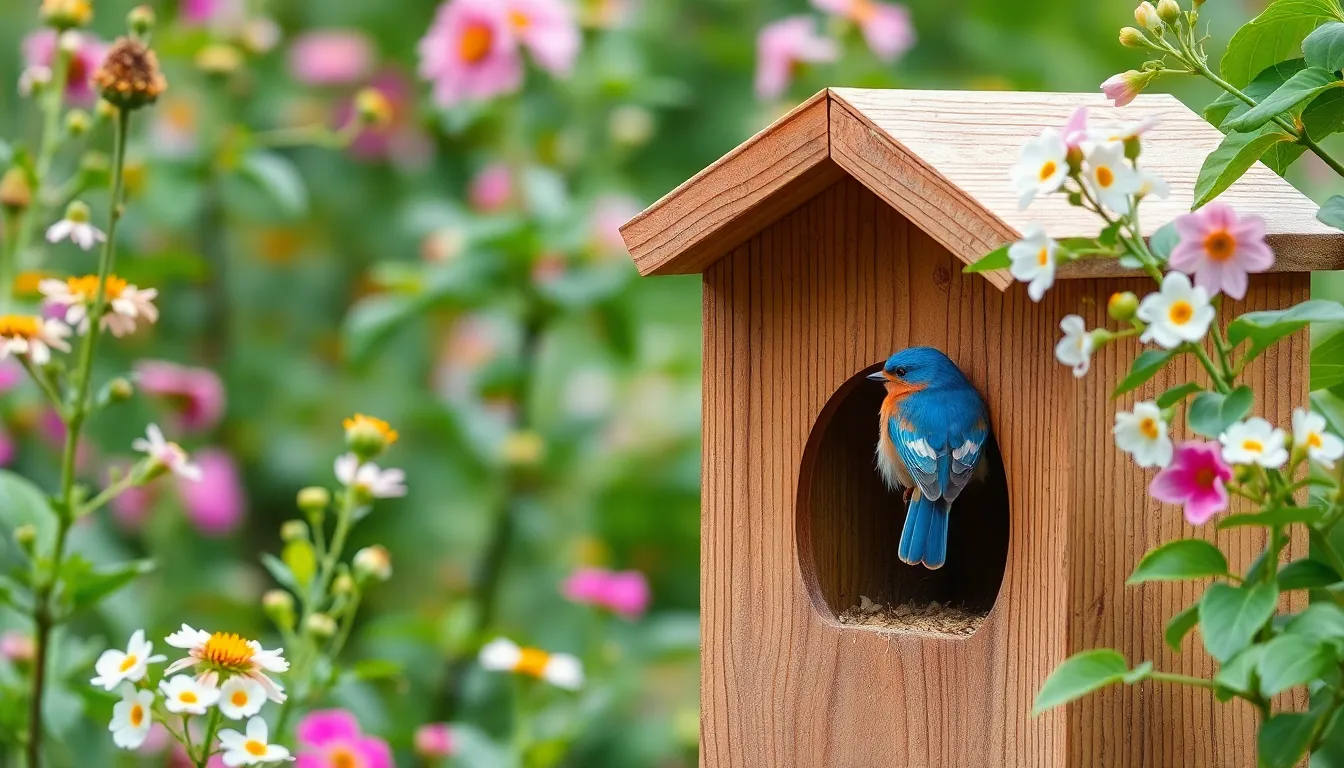
Blue birds demonstrate remarkable reproductive strategies that ensure species survival across diverse North American habitats. Their breeding cycles align with seasonal food availability and environmental conditions.
Breeding Season
Eastern Bluebirds begin their breeding season in March across southern regions, extending through August with peak activity occurring from April to July. These cavity nesters produce 2 to 3 broods annually when conditions remain favorable. Western Bluebirds initiate breeding slightly later in April, continuing through July in optimal habitats like oak woodlands and riparian areas. Mountain Bluebirds start their reproductive cycle in May due to harsh alpine conditions, typically completing 1 to 2 broods per season at elevations between 5,000 and 12,000 feet.
Blue Jays exhibit complex breeding behaviors from April through July, forming monogamous pairs that often mate for life. Indigo Buntings breed from May through August, with males arriving at breeding territories 1 to 2 weeks before females to establish dominance.
| Species | Breeding Season | Broods Per Year | Peak Activity |
|---|---|---|---|
| Eastern Bluebird | March – August | 2-3 | April – July |
| Western Bluebird | April – July | 2 | May – June |
| Mountain Bluebird | May – July | 1-2 | June |
| Blue Jay | April – July | 1 | May – June |
| Indigo Bunting | May – August | 1-2 | June – July |
Nest Building and Egg Laying
Cavity nesting defines the reproductive strategy for most blue bird species, with Eastern Bluebirds selecting natural tree hollows or artificial nest boxes positioned 4 to 6 feet above ground. Females construct cup-shaped nests using dried grasses, pine needles and feathers over 4 to 5 days. Eastern Bluebird females lay 3 to 7 pale blue eggs, with clutches averaging 4.7 eggs during first broods and 4.2 eggs in subsequent broods.
Western Bluebirds choose similar cavity locations, often competing with Tree Swallows and House Wrens for prime nesting sites. Females build nests using fine grasses and plant fibers, laying 4 to 6 blue eggs with occasional white variations. Mountain Bluebirds adapt to harsh alpine environments by nesting in rock crevices, old woodpecker holes and cliff faces at elevations exceeding 10,000 feet.
Blue Jays construct platform nests 10 to 25 feet high in deciduous trees using twigs, bark strips and moss. Females lay 3 to 6 olive-colored eggs with brown spots, incubating them for 17 to 18 days. Indigo Buntings build compact cup nests in dense shrubs 3 to 10 feet above ground, with females laying 3 to 4 pale blue eggs that require 12 to 13 days of incubation.
Parental care involves both males and females in most species, with males defending territories while females incubate eggs. Eastern Bluebird males provide approximately 60% of food during the nestling period, bringing insects every 6 to 20 minutes throughout daylight hours. Fledgling periods range from 16 to 21 days for most species, with parents continuing to feed young birds for 2 to 3 weeks after they leave the nest.
Blue Bird Symbolism and Cultural Significance
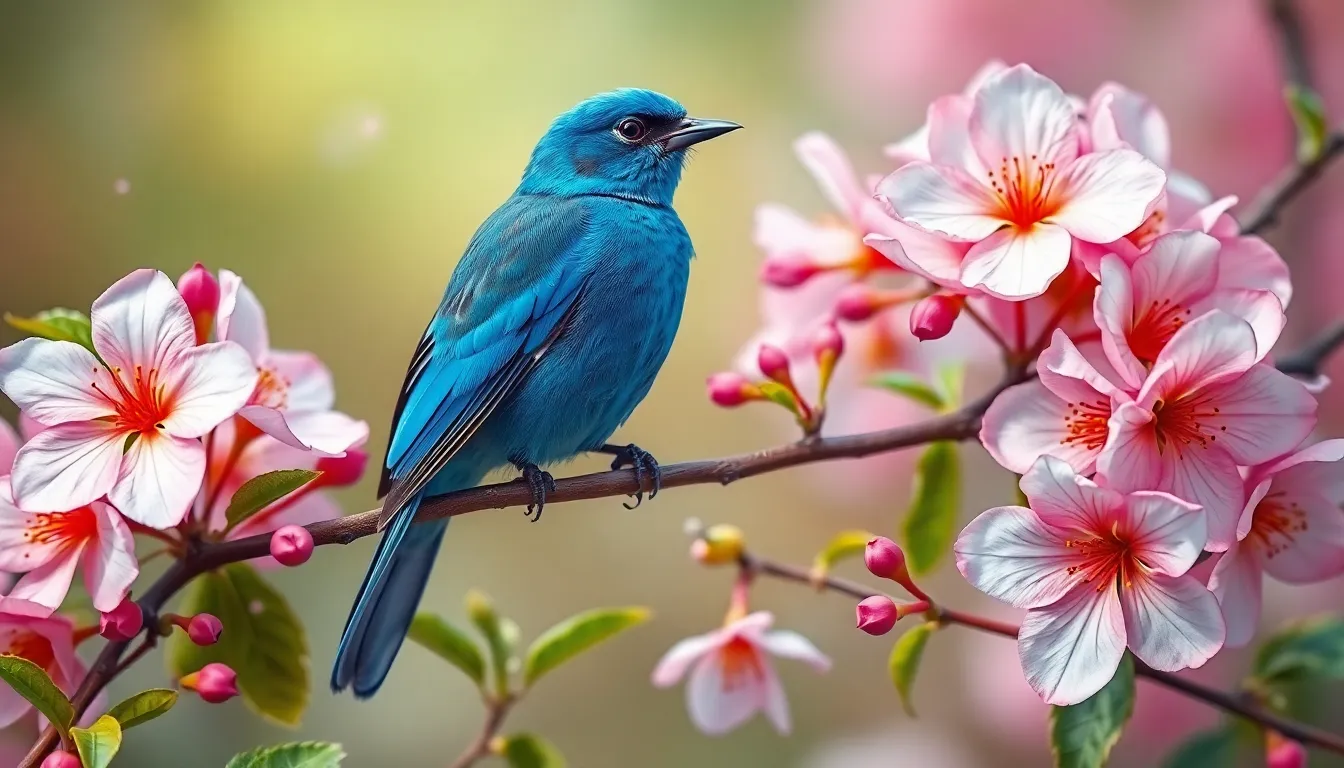
Blue birds carry profound symbolic meaning across many cultures worldwide. These vibrant creatures represent happiness, renewal, and spiritual transformation in folklore traditions spanning centuries. Native American tribes, particularly the Cherokee and Navajo, consider blue birds sacred messengers connecting the earthly area with spiritual dimensions.
Christianity embraces blue birds as symbols of divine hope and resurrection. Medieval European literature frequently depicts these birds as harbingers of joy and positive change. The association with happiness became particularly prominent in early 20th-century American culture, immortalized in the phrase “bluebird of happiness.”
Mythological Interpretations
Ancient Greek mythology connects blue birds with Athena, goddess of wisdom and strategic warfare. Egyptian hieroglyphs feature blue bird symbols representing the soul’s journey through the afterlife. Chinese culture views blue birds as messengers of the Queen Mother of the West, bringing news from celestial realms.
Scandinavian folklore describes blue birds as companions to thunder gods, carrying messages between worlds during storms. Russian fairy tales portray blue birds as magical creatures granting wishes to pure-hearted individuals. These mythological connections demonstrate the universal appeal of blue bird symbolism across diverse civilizations.
Modern Cultural Impact
Contemporary literature continues celebrating blue birds as symbols of optimism and perseverance. Popular music, including works by Irving Berlin and Charles Chaplin, reinforces the happiness association through iconic songs. Environmental conservation movements adopt blue bird imagery to represent the fragility and beauty of natural ecosystems.
Art therapy practices use blue bird symbolism to encourage emotional healing and personal growth. Psychology recognizes the blue bird metaphor as representing the pursuit of happiness and fulfillment. Corporate branding frequently employs blue bird imagery to convey trustworthiness, freedom, and positive transformation.
The cultural significance of blue birds extends beyond mere aesthetics, embodying humanity’s deepest aspirations for joy, spiritual connection, and harmonious relationships with nature. Their enduring presence in cultural expressions reflects our collective desire to find meaning and beauty in the natural industry.
Conservation Status and Threats
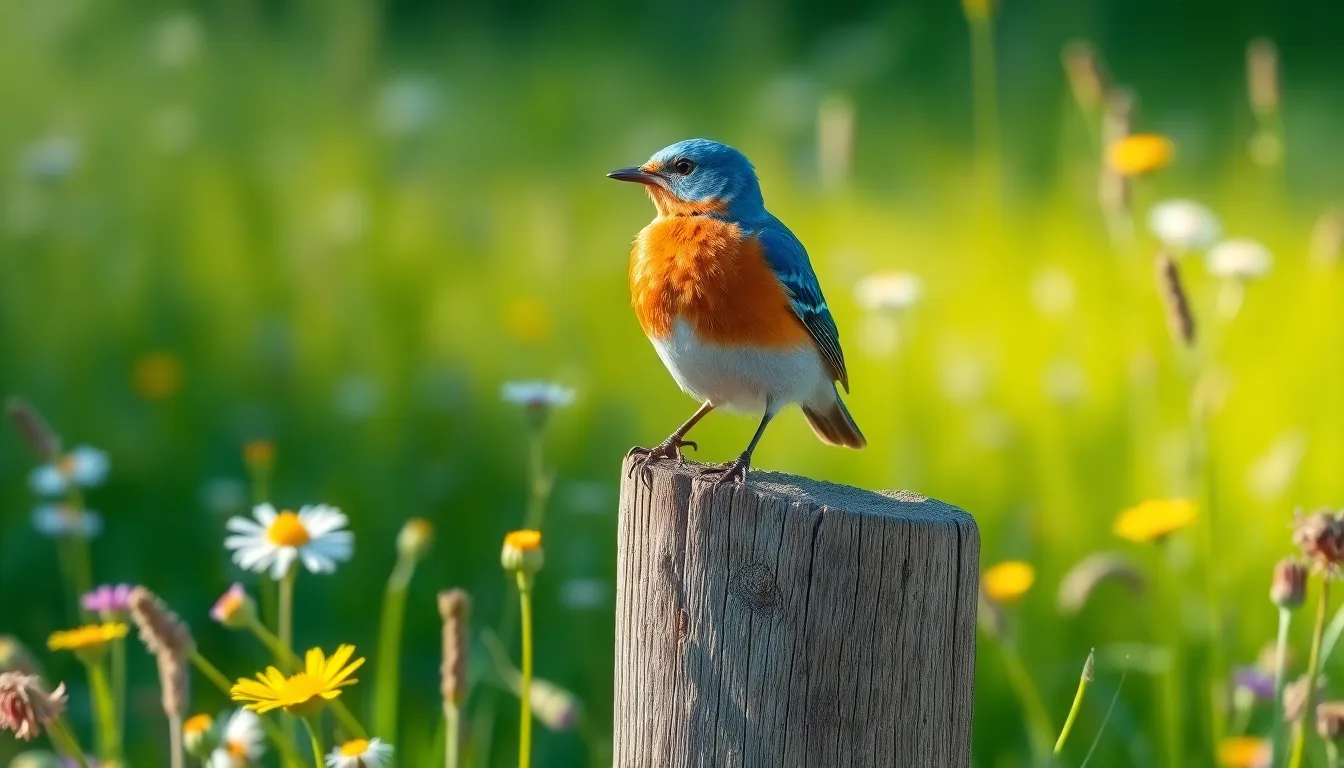
Blue bird populations across North America face varying conservation challenges that require targeted protection strategies. The North American Breeding Bird Survey indicates Eastern Bluebird populations have increased by 2.9% annually since 1970 due to successful nest box programs. Western Bluebird numbers remain stable in most regions, though local declines occur in California and Oregon where habitat loss affects 15% of breeding territories annually.
Mountain Bluebirds experience the greatest conservation concerns among true bluebird species, with populations declining 1.4% per year over the past five decades. Climate change poses important risks to their high-altitude habitats, forcing breeding ranges upward by an average of 328 feet per decade. Alpine ecosystems face temperature increases that alter insect availability and nesting site conditions.
Primary Conservation Threats
Habitat destruction represents the most important threat to blue bird species across their ranges. Agricultural intensification eliminates 3.2 million acres of suitable bluebird habitat annually, removing fence posts, scattered trees, and edge habitats essential for nesting. Urban development fragments remaining territories, creating isolated populations unable to maintain genetic diversity.
Competition from invasive species creates additional pressure on native blue bird populations. European Starlings and House Sparrows occupy 40% of available nesting cavities in agricultural areas, forcing bluebirds to search for alternative sites. These invasive species often destroy bluebird eggs and nestlings, reducing reproductive success by up to 60% in affected territories.
| Conservation Threat | Eastern Bluebird Impact | Western Bluebird Impact | Mountain Bluebird Impact |
|---|---|---|---|
| Habitat Loss | Moderate | High | Severe |
| Invasive Species | High | Moderate | Low |
| Climate Change | Low | Moderate | Severe |
| Pesticide Use | Moderate | Moderate | Low |
| Window Strikes | Low | Low | Moderate |
Pesticide applications reduce insect availability by 70% in treated agricultural areas, forcing blue birds to travel greater distances for food. Neonicotinoid pesticides accumulate in insect prey, causing neurological effects that impair hunting abilities and navigation skills. Organic farming practices support 3.5 times more insects than conventional methods, providing better foraging opportunities.
Conservation Success Stories
Nest box programs demonstrate remarkable success in supporting blue bird populations throughout their ranges. The North American Bluebird Society coordinates over 50,000 volunteers who maintain 300,000 nest boxes across the continent. These programs increase breeding success rates from 45% in natural cavities to 78% in properly maintained artificial nest boxes.
Bluebird trail networks create connected habitats that support population recovery and genetic exchange. The Transcontinental Bluebird Trail spans 5,000 miles from Idaho to Nova Scotia, providing nesting opportunities every quarter mile along suitable habitat corridors. State programs in Missouri, Wisconsin, and Minnesota report population increases of 400% since implementing systematic nest box monitoring.
Agricultural conservation programs offer financial incentives for farmers to maintain blue bird friendly practices. The Conservation Reserve Program protects 24 million acres of grassland and edge habitat that supports breeding pairs. Farm bill provisions encourage organic practices and habitat restoration that benefit insectivorous bird species like bluebirds.
Current Protection Measures
Federal legislation protects blue bird species under the Migratory Bird Treaty Act, making it illegal to harm birds, nests, or eggs without proper permits. State wildlife agencies monitor populations through annual breeding bird surveys and coordinate with conservation organizations to carry out protection strategies.
Research initiatives track blue bird population trends and identify emerging threats through banding programs and GPS tracking studies. Scientists monitor 15,000 banded bluebirds annually to understand migration patterns, survival rates, and habitat preferences. Citizen science projects engage 25,000 volunteers in collecting population data and nest monitoring information.
Educational outreach programs teach landowners how to create and maintain blue bird friendly environments. Extension services provide technical assistance for proper nest box installation, predator protection, and habitat management. School programs introduce students to blue bird conservation, fostering environmental stewardship in future generations.
How to Attract Blue Birds to Your Yard
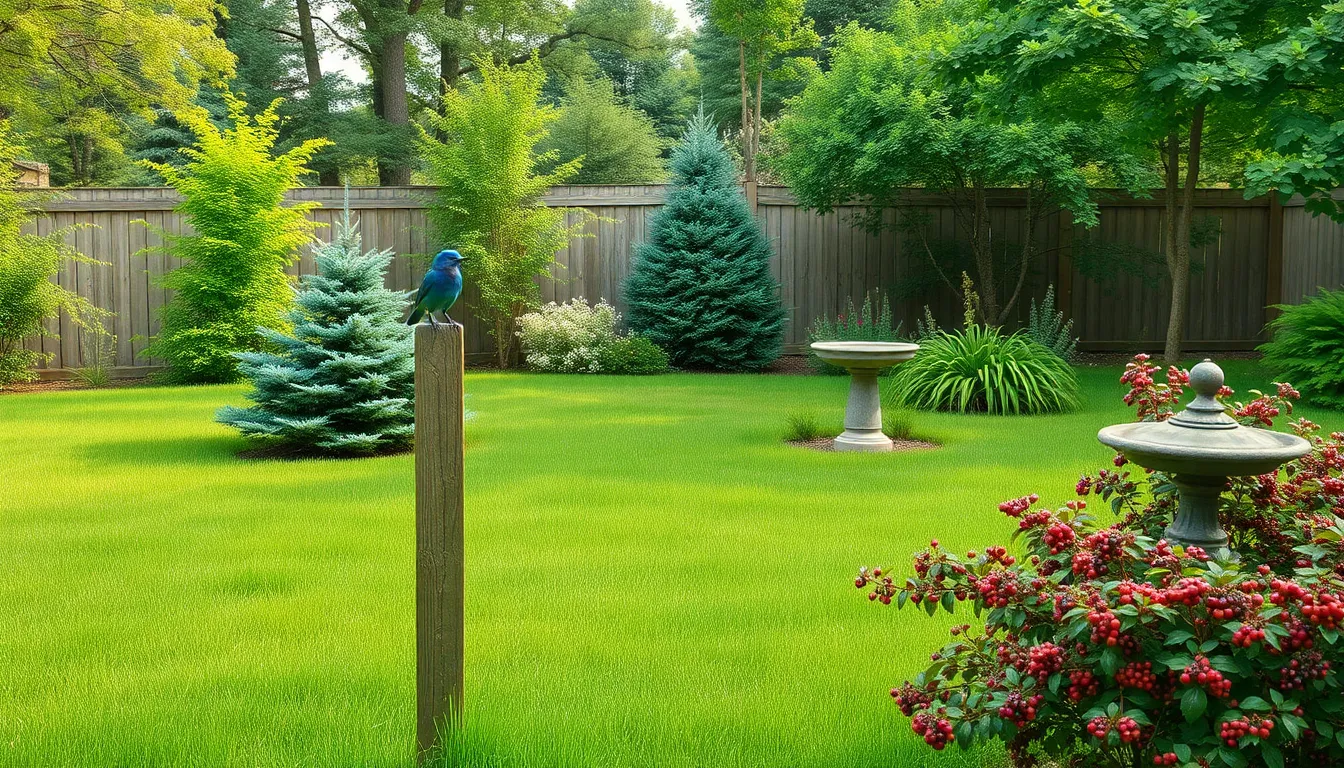
Attracting blue birds to our yards requires understanding their exact habitat preferences and providing essential resources they seek. Successful blue bird attraction combines environmental modifications with consistent food and water sources plus appropriate nesting opportunities.
Creating the Right Environment
Blue birds thrive in open spaces with scattered perches that mimic their natural habitats. We create ideal conditions by maintaining short grass areas where Eastern Bluebirds can spot ground-dwelling insects from elevated positions. Trees and shrubs positioned 100 to 300 feet apart provide perfect hunting perches while allowing clear flight paths between observation points.
Pesticide elimination becomes crucial since blue birds consume 68% to 85% insects during breeding season depending on species. Native plant landscaping attracts the insects blue birds prefer while creating natural foraging opportunities throughout our property. Oak trees particularly benefit Western Bluebirds by supporting oak woodland insects and providing natural cavity sites.
Edge habitats where lawn meets wooded areas replicate the farmland and woodland borders blue birds naturally seek. We maintain these transition zones by avoiding dense plantings that obstruct their hunting visibility. Fence posts and utility lines offer additional perching structures that complement our industry design.
Providing Food and Water Sources
Mealworms serve as the primary attractant for all blue bird species during breeding season when protein requirements peak. We offer live or dried mealworms in shallow dishes placed near potential nesting sites to encourage territory establishment. Fresh mealworms contain 20% protein compared to 53% in dried varieties though both effectively supplement natural insect hunting.
Native berry producing plants provide essential winter food sources when insect availability decreases. Elderberry sumac dogwood and holly species support blue bird populations through cold months while requiring minimal maintenance. We plant these shrubs in clusters rather than single specimens to maximize berry production.
Shallow water features positioned 6 to 12 inches from ground level accommodate blue bird bathing and drinking preferences. Birdbaths with rough surfaces and gentle slopes allow secure footing while dripping or circulating water creates auditory attraction. We maintain water depth between 1 to 2 inches to prevent drowning while ensuring accessibility for different blue bird sizes.
Installing Nest Boxes
Proper nest box specifications vary by target species with Eastern Bluebirds requiring 5×5 inch floor dimensions and 1.5 inch entrance holes. Western Bluebirds use identical specifications while Mountain Bluebirds prefer slightly larger 5×5.5 inch floors with 1.56 inch entrance diameters. We position boxes 5 to 6 feet above ground on poles rather than trees to reduce predator access.
Spacing between nest boxes affects territory establishment with 100 yards minimum distance preventing competitive conflicts between breeding pairs. Multiple species occupy closer territories so we install different box types within 50 yards when targeting various blue bird species. Entrance holes face east or southeast to capture morning sun while avoiding afternoon heat stress.
Ventilation holes drilled below roof lines and drainage holes in floor corners prevent moisture accumulation that causes nest failure. We use untreated wood construction with removable tops for annual cleaning between breeding seasons. Predator guards consisting of metal baffles below mounting poles eliminate climbing predators like snakes and raccoons.
Monitoring boxes weekly during breeding season helps track occupancy and breeding success while allowing intervention if problems develop. House Sparrow and European Starling removal protects blue bird nesting attempts since these invasive species compete aggressively for cavity sites. We record data on egg laying clutch sizes and fledgling success to evaluate our attraction methods effectiveness.
Conclusion
We’ve explored the remarkable industry of blue birds and discovered why these stunning creatures continue to captivate birdwatchers and nature enthusiasts alike. From the brilliant plumage of Eastern Bluebirds to the intelligent behaviors of Blue Jays each species brings its own magic to our natural landscapes.
Our journey through their habitats feeding patterns and conservation efforts reveals just how interconnected these birds are with healthy ecosystems. By understanding their needs and implementing simple yard modifications we can play a vital role in supporting their populations for future generations.
The next time you spot a flash of blue in your garden or hear their melodious songs remember that you’re witnessing one of nature’s most cherished symbols of hope and renewal. These feathered ambassadors remind us that small actions in our own backyards can make a meaningful difference in wildlife conservation.
Frequently Asked Questions
What are the most common types of blue birds in North America?
The most common blue birds in North America include Eastern Bluebirds, Western Bluebirds, Mountain Bluebirds, Blue Jays, and Indigo Buntings. Eastern Bluebirds have blue upperparts with rusty orange breasts, Western Bluebirds feature deeper blue tones with chestnut shoulders, Mountain Bluebirds display entirely blue plumage in males, Blue Jays are the largest with distinctive crests, and Indigo Buntings show deep indigo coloration during breeding season.
How can I tell the difference between male and female blue birds?
Male blue birds typically display more vibrant, brilliant blue coloration compared to females. For example, male Eastern Bluebirds have bright blue upperparts and rusty orange breasts, while females show more subdued gray-blue colors. This sexual dimorphism is common across most blue bird species, with males being more colorful to attract mates during breeding season, while females have duller plumage for camouflage while nesting.
What do blue birds eat and how do their diets change seasonally?
Blue birds have diverse diets that adapt to seasonal availability. During breeding season, they consume primarily insects – Eastern Bluebirds eat 68% insects, Western Bluebirds 70%, and Mountain Bluebirds 85%. In winter, they switch to berries and fruits. Blue Jays are omnivorous, eating insects, nuts, seeds, and small animals. Indigo Buntings prefer seeds year-round but also consume insects during breeding to feed their young.
Where do blue birds prefer to nest and how many broods do they have?
Blue birds are cavity nesters, preferring natural tree holes, old woodpecker holes, or nest boxes. Eastern Bluebirds produce 2-3 broods annually starting in March, Western Bluebirds have 2 broods beginning in April, and Mountain Bluebirds produce 1-2 broods starting in May. Blue Jays build open cup nests in trees and typically have one brood, while Indigo Buntings nest in shrubs with 1-2 broods per season.
How can I attract blue birds to my yard?
To attract blue birds, create open spaces with scattered perches like fence posts or dead branches. Plant native berry-producing plants such as elderberry, sumac, and dogwood. Install appropriate nest boxes 4-6 feet high, spaced 300 feet apart for territorial species. Eliminate pesticide use to ensure insect availability. Provide fresh water sources and maintain some open ground for foraging. Different species prefer different habitats, so research local blue bird preferences.
What is the conservation status of blue bird populations?
Conservation status varies by species. Eastern Bluebird populations have increased thanks to successful nest box programs. Western Bluebirds remain stable overall but face local declines. Mountain Bluebirds are of greatest conservation concern due to climate change and habitat loss in high-altitude regions. Primary threats include habitat destruction, invasive species competition, and pesticide use. The Migratory Bird Treaty Act protects all blue bird species federally.
When and where do blue birds migrate?
Migration patterns vary by species and location. Eastern Bluebirds in northern regions migrate south in fall, while southern populations may remain year-round. Western Bluebirds show similar patterns, with mountain populations moving to lower elevations. Mountain Bluebirds are highly migratory, traveling from breeding grounds to wintering areas in Mexico. Indigo Buntings migrate impressive distances to Central America, while Blue Jays have complex, partially migratory patterns.
What cultural significance do blue birds hold?
Blue birds symbolize happiness, renewal, and spiritual transformation across many cultures. Native American tribes view them as sacred messengers connecting earth and sky. In Christianity, they represent divine hope and resurrection. Ancient mythologies link them to wisdom and the afterlife. Modern culture celebrates them as icons of optimism, inspiring the famous song “Bluebird of Happiness” and numerous literary works, making them enduring symbols of joy and connection with nature.

